1.Great Look at The U.S. Economy Being Much Less Sensitive to Higher Oil Prices.
Torston Slok The US economy is much less sensitive to higher oil prices today than it used to be, see chart below and here.

———————————————–
Let us know if you would like to add a colleague to this distribution list.
Torsten Sløk, Ph.D.
Chief Economist
Managing Director
2.Hedge Funds Heavy Oil Bet
From Dave Lutz at Jones Trading
RHETORIC RAMP– Iran is considering 13 scenarios to avenge the killing of a top Iranian military commander in Iraq by a U.S. drone attack – Even the weakest option would prove “a historic nightmare for the Americans,” they said. Iran’s Supreme Leader Ayatollah Ali Khamenei and military commanders have said Iranian retaliation for the U.S. action on Friday would match the scale of Soleimani’s killing but that it would be at a time and place of Tehran’s choosing.

Despite its strident rhetoric, analysts say Iran will want to avoid any conventional conflict with the United States but assymetric strikes, such as sabotage or other more limited military actions, are more likely.

Trump administration officials will provide a classified briefing for U.S. senators on Wednesday on events in Iraq after some lawmakers accused the White House of risking a broad conflict without a strategy.
From Dave Lutz at Jones Trading
3.Good Look at the Difference Between 10 and 20 Year Market Returns.
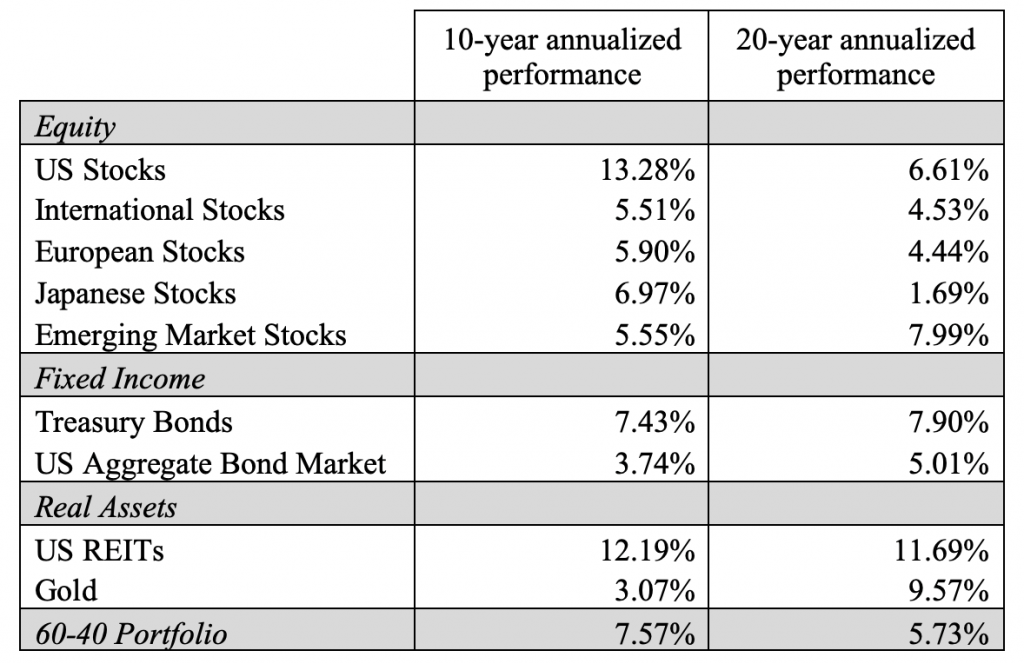
Silicon Hills Wealth
4.2019 Returns Were All Multiple Expansion….Fed Lowering Rates
Alliance Bernstein Blog
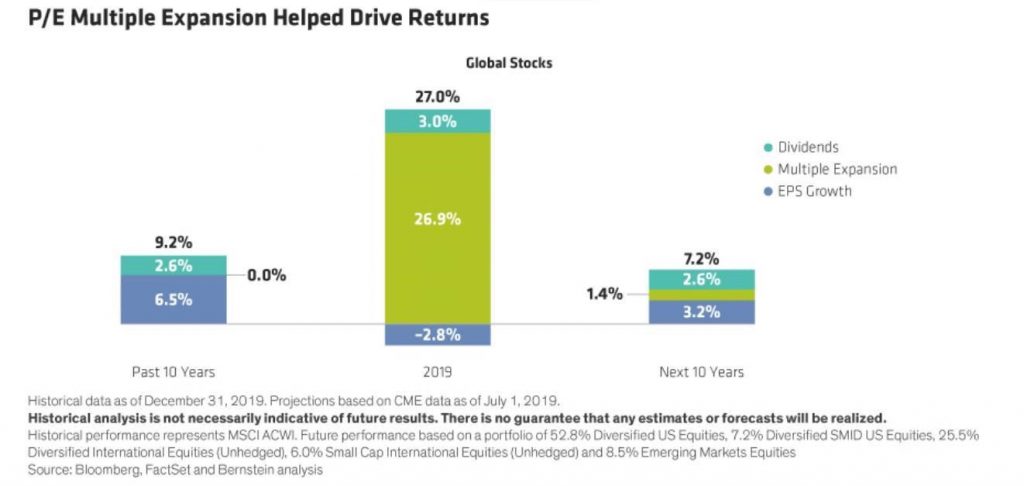
5.History of Returns Vs. Standard Deviation.
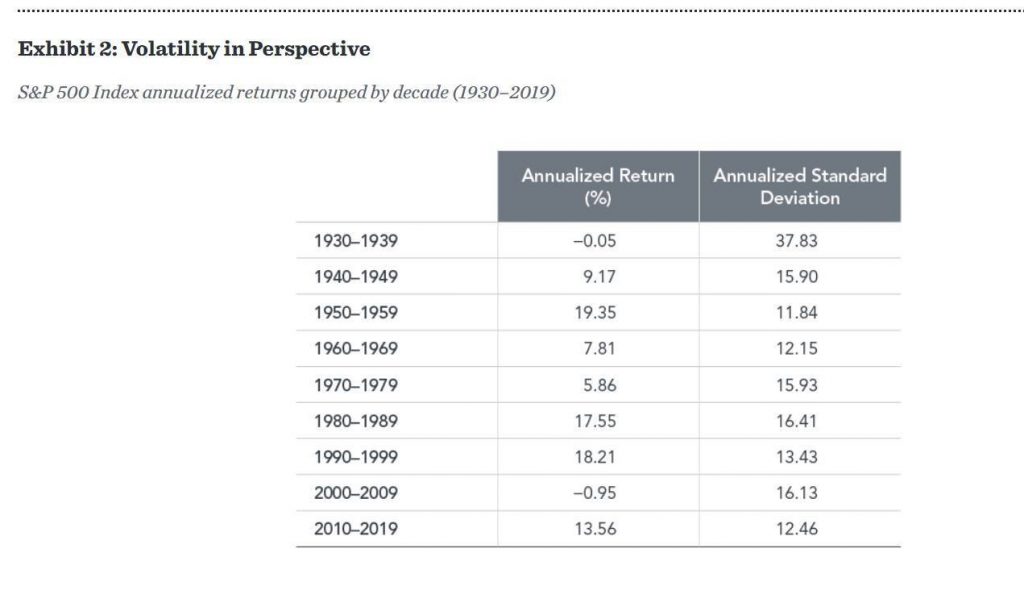
Dimensional Funds
https://us.dimensional.com/perspectives/the-2010s-a-decade-in-review
6.Record Extreme In Bond Flows Vs. Stock Flows.
The flow into bonds has exceeded the flow into stocks by $600b-NED DAVIS RESEARCH
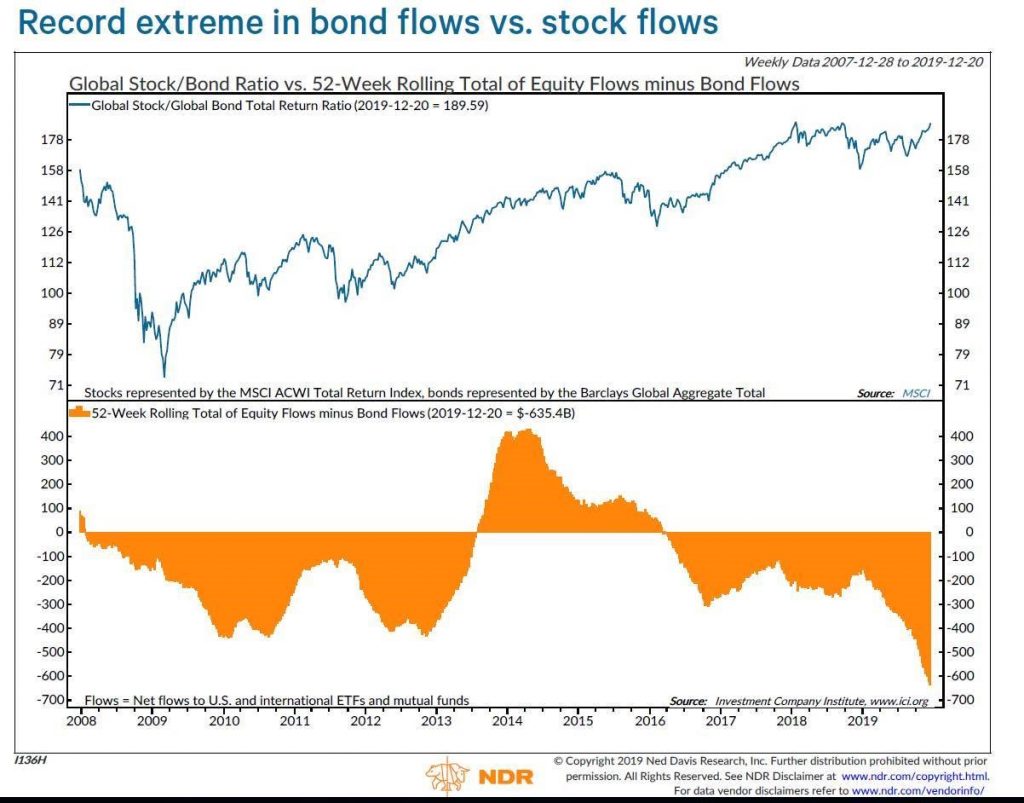
7.U.S. Stocks More Expensive Than International Across All Measures.
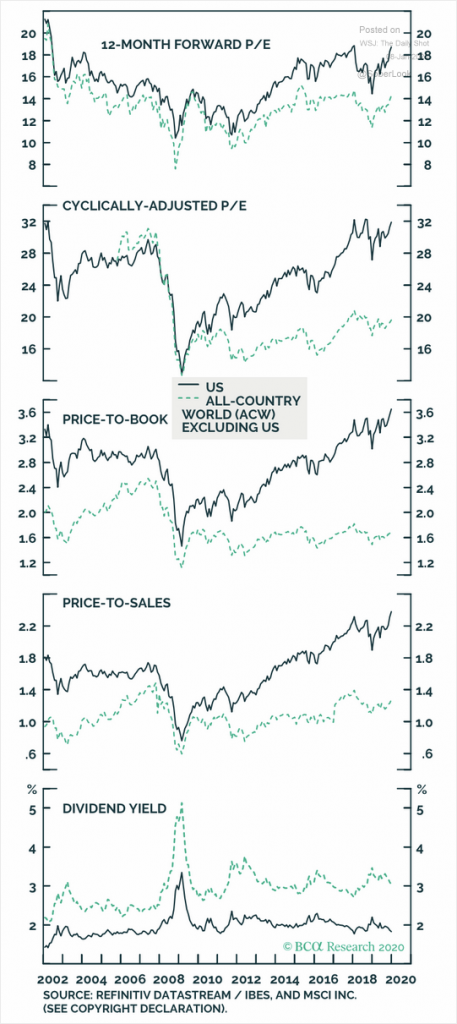
BCA RESEARCH
WSJ-The Daily Shot
8.Who Knew? Who Came Up With the Concept of Old Age?
Hartford Funds
Who Came Up With The Concept Of “Old Age” Anyway?
Our very notion of “old age” is made up. It’s a socially constructed, historically contingent, and deeply flawed idea. This narrowly focused narrative no longer applies to a majority of us—yet, we tell it every day. We still agree to live it.
A Time When You Didn’t Retire
% working after age 641
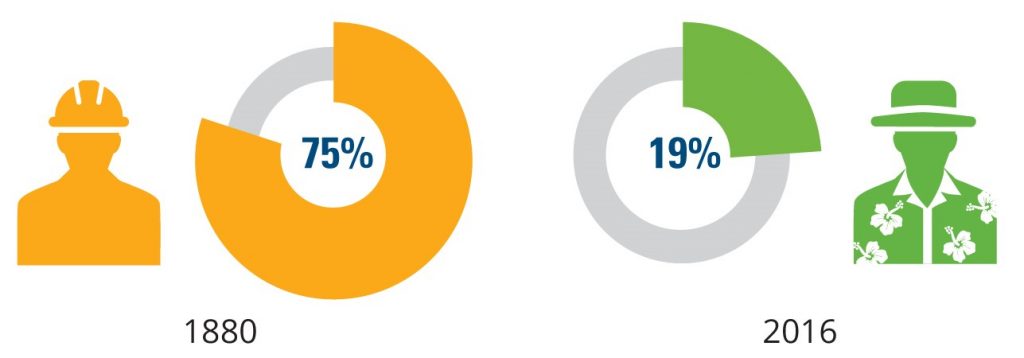
75% of workers 65 and older were employed in 1880. By 2016, that number had dropped to 19%. Why? Prior to pensions and Social Security, aging workers knew that if they stopped working, they’d have to rely on family for support. Or worse, they might have to move into an almshouse, where they could have possibly found themselves bunking next to some unsavory characters.
The Origins Of Retirement
It wasn’t so long ago when a completely different idea of aging was taken for granted in the United States. Our current story of “old age” began in the second half of the 19th century. Though it was first told in a much different world than we live in today, it’s still the measuring stick we use.
The Union Army Pension, instituted in 1890, provided payments to American Civil War veterans and their wives when a recipient hit his 60s. Prior to its existence, retirement was not something aging workers looked forward to very much. It meant you weren’t too far away from death.
This pension provided the first indication that this norm might change and a subset of the population would voluntarily stop working before they were physically unable to continue.
9.US cancer death rate sees largest-ever single-year drop, report says
By Jacqueline Howard, CNN
(CNN)The rate of people dying from cancer in the United States continued to decline for the 26th year in a row, according to a new American Cancer Society report.
From 2016 to 2017, the United States saw its largest-ever single-year drop in overall cancer deaths, a 2.2% plunge spurred in part by a sharp decline in lung cancer deaths, according to the report, published Wednesday in CA: A Cancer Journal for Clinicians.
More people are surviving lung cancer in the US, report finds
“What is really driving that is the acceleration in the decline of mortality for lung cancer, and the reason that is encouraging is because lung cancer is the leading cause of cancer death, causing more deaths in the US than breast, colorectal cancer and prostate cancers combined,” said Rebecca Siegel, first author of the report and scientific director of surveillance research at the American Cancer Society in Atlanta.
“That’s really important and reflects improvements in the treatment of lung cancer across the continuum from improvements in staging to advances in surgical techniques, improvements in radiotherapy, all of these things coming together,” she said. “We were very encouraged to see that not only is the decline continuing for cancer mortality but we saw the biggest single-year drop ever from 2016 to 2017.”
Reductions in smoking, improvements in treatment
The report included data on cancer incidence, mortality and survival in the United States from sources including the National Center for Health Statistics, National Cancer Institute’s Surveillance, Epidemiology and End Results Program, the National Program of Cancer Registries and the North American Association of Central Cancer Registries. Some of the information dates back to 1930 and the most recent data is from 2017. Using that data, the report also projects estimated numbers of new cases and deaths that could emerge in the United States in 2020.
US cancer death rate hits 25 years of decline, study says
An analysis of the data showed that, since its peak of about 215 cancer deaths for every 100,000 people in 1991, the cancer death rate in the United States has continued to fall.
The report found an overall drop of 29% as of 2017, which translates into an estimated 2.9 million fewer cancer deaths than what would have occurred if death rates had remained at their peak, according to the report.
“We’ve had this continuous decline in the cancer death rate for the past 26 years,” Siegel said.
“The biggest driver is the reductions in smoking, but also contributing are improvements in treatment as well as early detection for some cancers, like breast and colorectal cancer,” she said. “It was exciting that we’re seeing that decline continue because for other leading causes of death like heart disease and cerebrovascular disease progress is really slowing and in fact death rates have stabilized for cerebrovascular disease,” or stroke.
Heart disease remains the leading cause of death in the United States, and cancer ranks as the second leading cause of death in the United States.
Cancer death rates drop, heart disease deaths on the rise for US adults
The report noted that declines in death due to four major cancers — lung, breast, prostate and colorectal — reflect the progress that has been made against the disease.
As of 2017, the death rate for lung cancer dropped by 51% among men since its peak in 1990 and by 26% among women since its peak in 2002, the report found.
The report also found that, as of 2017, the death rate for female breast cancer fell 40% since its peak in 1989. The death rate for prostate cancer fell by 52% since 1993, the death rate for colorectal cancer among men fell by 53% since 1980 and the death rate for colorectal cancer among women fell by 57% since 1969.
10.How to Avoid 4 Leadership Blindspots and Save Yourself from Yourself
- Published on January 3, 2020
Associate Professor & Associate Director of the Practice of Managerial Studies at Va… See More
314 articles Follow
We all have blind spots. These are things that others know about you, but about which you are completely clueless. They can be small things…
- A stain on your shirt that everyone sees – except you.
- A conversation that you arrive late to and say something out of place. Everyone knows the arc of the discussion – except you.
- A mispronounced word when speaking a foreign language. Everyone correctly says it – except you.
If you survived your teenage years, you’ve no doubt had at least one of these experiences. You might be embarrassed when the blind spot is revealed; however, the damage is typically not too significant – at least in the long-run.
On the other hand, if you are in a leadership role, some of these blind spots can be particularly costly. They can impact your professional reputation, performance, and organizational results.

In 1955, American psychologists Joseph Luft and Harrington Ingham created the Johari window to help us better understand how we interact with others. They taught us four areas: open, hidden, unknown, and blind spots.
Open: Known to you and others (e.g., a certain skill, work experience, etc.)
Hidden: Known to you, but unknown to others (e.g., an insecurity, unrevealed feeling, etc.)
Unknown: Neither known to you or others (e.g., a bias that you have yet to discover, a fear that you haven’t uncovered, a capability that you never had reason to know you possessed)
Blind: Known to others, but not known to you. These are blind spots.
There are many potential blind spots, but I find these four are particularly pervasive and costly. Each is based on a specific assumption. Are you falling prey to any of these?
1. Assuming People Know the Goals
Research suggests that only 15% of people can actually name their leaders’ most important goals. But, many leaders assume everyone knows what’s most important.
I once worked with a client who swore all of his employees knew the top goal and challenged me to prove him wrong. The next day I presented a list of 23 different goals that his employees said were most important. All 23 stemmed from the leader. Although the leader saw himself as the goal-oriented, visionary-type, they felt he hadn’t met an idea that he didn’t like. Consider these questions:
- What are the 1-3 most important goals for your team or organization?
- Do your people know the goals?
- How do you know they know them?
2. Assuming People Know What They Should Do
Clarifying and communicating a goal is critical, but insufficient. Employees also need to understand how their work connects to the stated goals. Assuming people understand the connection, or that a connection exists at all, is another leadership blind spot.
When you assume people know what to do, you may walk out of your meetings asking each other questions like, “That sounds like a great idea, but what can we do to impact that goal?” In these instances, people don’t feel empowered; they feel abandoned. Consider these questions:
- Do your people know what they can do to accomplish the goals?
- Do they understand how their daily work drives goal accomplishment?
3. Assuming You Know How to Best Do Your Employees’ Jobs
Sometimes a leader assumes that he or she knows best how to accomplish the goal. The leader both tells the people the goal and how to do it. Unlike the abandonment issue above, these leaders are micromanaging. The leader assumes he is being helpful, but the people simply believe that they are not trusted. Of course, this is a bad situation, but it’s even worse if the leader doesn’t really know how best to do the task.
- Do you ask your people how they might choose to go about accomplishing the goals?
- Are you too directive?
- Could you be violating the concept that involvement breeds commitment.
4. Assuming You Know What Your People Find Motivating
Different things motivate people. What one might consider a reward, another thinks is far from positive recognition. Some leaders assume that if they personally find something motivating that their people will feel the same.
Be mindful that a financial reward isn’t too motivating if the employees simply want a few extra hours of free time. Most of your folks already have enough t-shirts and coffee mugs. Moreover, a pat on the back or a hand written note is sometimes reward enough. If you really want to know what motivates your people, don’t assume, ask.
- How effective have your last reward/incentive programs been?
- Do you know what truly motivates your people?
- When was the last time you asked them?
——
Join the 99,500+ who follow Dr. Patrick Leddin on LinkedIn. Just click ‘follow’ next to his name to gain access to all of his leadership insights. Leading others can be tough. Great ideas make it a bit easier!
@linkedineditors
Report this
Published by
Associate Professor & Associate Director of the Practice of Managerial Studies at Vanderbilt University, Public Speaker
Published • 4d